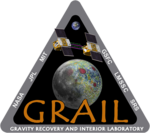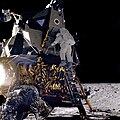Space Shuttle Grail (disambiguation)
 Artist's interpretation of the GRAIL tandem spacecraft above the lunar surface | |
| Operator | NASA / JPL |
|---|---|
| Major contractors |
Lockheed Martin Space Systems Massachusetts Institute of Technology |
| Mission type | Orbiter |
| Satellite of | The Moon |
| Orbital insertion date | December 31, 2011 (Ebb), January 1, 2012 (Flow) |
| Launch date | 2011-09-10, 13:08:52.775 UTC |
| Launch vehicle | Delta II 7920H-10 configuration (D-356) |
| Launch site | Cape Canaveral SLC-17B |
| Mission duration | March 2012 - December 2012 |
| COSPAR ID | 2011-046A |
| Homepage | http://moon.mit.edu |
| Mass |
132.6 kg (Template:Convert/round lb) (dry) 202.4 kg (Template:Convert/round lb) (fueled)[1] |
| Power | (Solar array / Li-ion battery) |
| References: [2][3] | |
 GRAIL mission logo | |

MoonKAM shot
The Gravity Recovery and Interior Laboratory (GRAIL) was an American lunar science mission in NASA's Discovery Program which used high-quality gravitational field mapping of the Moon to determine its interior structure. The two small spacecraft GRAIL A (Ebb) and GRAIL B (Flow)[4] were launched on 10 September 2011 aboard a single launch vehicle: the most-powerful configuration of a Delta II, the 7920H-10.[2][5][6] GRAIL A separated from the rocket about nine minutes after launch, GRAIL B followed about eight minutes later. They arrived at their orbits around the Moon 25 hours apart.[7][8] The first probe entered orbit on 31 December 2011 and the second followed on 1 January 2012.[9] The two spacecraft impacted the Lunar surface on December 17, 2012.[10]
Overview[]

Fourth grade students at Emily Dickinson Elementary School in Bozeman, Montana who suggested names Ebb and Flow.[4]
Maria Zuber of the Massachusetts Institute of Technology is GRAIL's principal investigator. NASA's Jet Propulsion Laboratory manages the project. As of August 5, 2011[update], the program has cost US$496 million.[11] Upon launch the spacecraft were named GRAIL A and GRAIL B and a contest was opened to school children to select names. Nearly 900 classrooms from 45 states, Puerto Rico and the District of Columbia, participated in the contest. The winning names, Ebb and Flow, were suggested by 4th grade students at Emily Dickinson Elementary School in Bozeman, Montana.[4]
Each spacecraft transmitted and received telemetry from the other spacecraft and Earth-based facilities. By measuring the change in distance between the two spacecraft, the gravity field and geological structure of the Moon was obtained. The two spacecraft were able to detect very small changes in the distance between one another. Changes in distance as small as one micron were detectable and measurable.[12][13] The gravitational field of the Moon was mapped in unprecedented detail.[14]
Objectives[]
- Map the structure of the lunar crust and lithosphere
- Understand the asymmetric thermal evolution of the Moon
- Determine the subsurface structure of impact basins and the origin of lunar mascons
- Ascertain the temporal evolution of crustal brecciation and magmatism
- Constrain the deep interior structure of the Moon
- Place limits on the size of the Moon's inner core
The data collection phase of the mission lasted from 7 Mar 2012 to 29 May 2012, for a total of 88 days. A second phase, at a lower altitude, of data collection began 31 Aug 2012,[15] and was followed by 12 months of data analysis.[14] On 5 Dec 2012 NASA released a gravity map of the Moon made from GRAIL data.[16] The knowledge acquired will aid understanding of the evolutionary history of the terrestrial planets and computations of lunar orbits.[17]
Spacecraft[]
Instruments[]

Gravity map of the Moon by GRAIL
- Ka band Lunar Gravity Ranging System (LGRS), derived from the Gravity Recovery and Climate Experiment instrument.[1] 90% of the GRACE software was reused for GRAIL.[18]
- Radio science beacon (RSB)
- Moon Knowledge Acquired by Middle school students (MoonKAM).[19] Each MoonKAM system (one per spacecraft) consists of a digital video controller and four camera heads.[20] Click here [1] for a MoonKAM photo from lunar orbit.
Propulsion[]
Thrusters aboard each spacecraft were capable of producing 22 newtons (Template:Convert/round lbf).[1] Each spacecraft was fueled with 103.5 kilograms (Template:Convert/round lb) of hydrazine to be used by the thrusters and main engine to enable the spacecraft to enter lunar orbit and transition to the science phase of its mission. The propulsion subsystem consisted of a main fuel tank and a Re-repressurization system which were activated shortly after lunar orbit insertion.[21]
Mission profile[]
Launch attempts[]
All times are in EDT (UTC-4). Template:LaunchAttempt
Transit phase[]

GRAIL-transit-Earth-Moon
Unlike the Apollo program missions, which took three days to reach the Moon, GRAIL made use of a three- to four-month low-energy trans-lunar cruise well outside the Moon's orbit and passing near the Sun-Earth Lagrange point L1 before looping back to rendezvous with the Moon. This extended and circuitous trajectory enabled the mission to reduce fuel requirements, protect instruments and reduce the velocity of the two spacecraft at lunar arrival to help achieve the extremely low 50 km (Template:Convert/round mi) orbits with separation between the spacecraft (arriving 25 hours apart) of 175 to 225 km (Template:Convert/round to Template:Convert/round mi).[17][22] The very tight tolerances in the flight plan left little room for error correction leading to a launch window lasting one second and providing only two launch opportunities per day.[23]
Science phase[]
The primary science phase of GRAIL lasted for 88 days, from 7 Mar 2012 to 29 May 2012. It was followed by a second science phase starting on 8 Aug.
The gravity mapping technique was similar to that used by Gravity Recovery and Climate Experiment (GRACE), and the spacecraft design was based on XSS-11.[24]
The orbital insertion dates were December 31, 2011 (for GRAIL-A) and January 1, 2012 (for GRAIL-B).[25]
The spacecraft were operated over the 88 day acquisition phase, divided into three 27.3 day long nadir-pointed mapping cycles. Twice each day there was an 8-hour pass in view of the Deep Space Network for transmission of science and "E/PO MoonKam" data.[26]
Terminal phase[]
Template:Multiple image
Template:Multiple image
Final experiment and mission end[]
At the end of the science phase and a mission extension, the spacecraft were powered down and decommissioned over a five-day period. The spacecraft impacted the lunar surface on December 17, 2012.[26][27][28][29][30][31] Both spacecraft impacted an unnamed lunar mountain between Philolaus and Mouchez at Template:Lunar coords and quad cat. Ebb, the lead spacecraft in formation, impacted first. Flow impacted moments later. Each spacecraft was traveling at 3,760 miles per hour (Template:Convert/round km/s). A final experiment was conducted during the final days of the mission. Main engines aboard the spacecraft were fired, depleting remaining fuel. Data from that effort will be used by mission planners to validate fuel consumption computer models to improve predictions of fuel needs for future missions.[32] NASA has announced that the crash site will be named after GRAIL collaborator and first American woman in space, Sally Ride.[33] Template:Multiple image
References[]
- ↑ 1.0 1.1 1.2 "Spacecraft and Payload". Massachusetts Institute of Technology. http://moon.mit.edu/spacecraft.html.
- ↑ 2.0 2.1 "Delta II Set to Launch NASA's GRAIL Mission". United Launch Alliance. 2011. http://www.ulalaunch.com/site/pages/Launch.shtml#/21/. Retrieved 2 September 2011.
- ↑ "The GRAIL Mission: A Fact Sheet". Sally Ride Science. 2010. http://www.grailmoonkam.com/about/grail_fact_sheet. Retrieved 2010-04-15.
- ↑ 4.0 4.1 4.2 Agle, DC. "Montana Students Submit Winning Names for NASA Lunar Spacecraft". NASA JPL. http://www.nasa.gov/home/hqnews/2012/jan/HQ_12-019_GRAIL_Name.html.
- ↑ Template:Cite paper
- ↑ Grey Hautaluoma (10 December 2007). "New NASA Mission to Reveal Moon's Internal Structure and Evolution". NASA. http://www.nasa.gov/home/hqnews/2007/dec/HQ_07274_Grail_Mission.html. Retrieved 31 August 2011.
- ↑ Moon-bound twin GRAIL spacecraft launch success
- ↑ Spaceflight101
- ↑ "First of NASA's GRAIL Spacecraft Enters Moon Orbit". NASA. http://www.nasa.gov/mission_pages/grail/news/grail20111231.html. Retrieved 1 January 2012.
- ↑ GRAIL Twins crash into the Moon to complete highly successful Mission
- ↑ Template:Cite news
- ↑ GRAVITY RECOVERY AND INTERIOR LABORATORY (GRAIL) MISSION: STATUS AT THE INITIATION OF THE SCIENCE MAPPING PHASE, 43rd Lunar and Planetary Science Conference (2012)
- ↑ Washington Post December 17, 2012
- ↑ 14.0 14.1 "About GRAIL". Massachusetts Institute of Technology. http://moon.mit.edu/index.html. Retrieved 2011-03-12.
- ↑ Gravity Recovery and Interior Laboratory: News & Features: NASA's GRAIL Moon Twins Begin Extended Mission Science. Solarsystem.nasa.gov. Retrieved on 2013-07-21.
- ↑ Gravity Recovery and Interior Laboratory: News & Features: NASA's GRAIL Creates Most Accurate Moon Gravity Map. Solarsystem.nasa.gov. Retrieved on 2013-07-21.
- ↑ 17.0 17.1 "GRAIL: Mission Overview". MIT. http://moon.mit.edu/overview.html. Retrieved 10 September 2011.
- ↑ "GRAIL: Mission Operations & Data Processing". MIT. http://moon.mit.edu/operations.html. Retrieved 2012-12-14.
- ↑ "About GRAIL MoonKAM". Sally Ride Science. 2010. http://www.grailmoonkam.com/about. Retrieved 2010-04-15.
- ↑ "GRAIL Launch Press Kit". NASA. http://solarsystem.nasa.gov/grail/docs/GRAIL%20launch%20press%20kit1.pdf. Retrieved 31 August 2011.
- ↑ GRAIL (Gravity Recovery and Interior Laboratory)
- ↑ "Mission Design". NASA. http://solarsystem.nasa.gov/grail/missiondesign.cfm. Retrieved 10 September 2011.
- ↑ Template:Cite news
- ↑ Template:Cite news
- ↑ Cite error: Invalid
<ref>tag; no text was provided for refs namedLaunchCBS - ↑ 26.0 26.1 "GRAIL: Mission Design". MIT. http://moon.mit.edu/design.html.
- ↑ "NASA GRAIL Twins Complete Their Moon Impact". NASA. 17 December 2012. http://www.nasa.gov/mission_pages/grail/news/grailstatus20121217.html. Retrieved 2012-12-17.
- ↑ Template:Cite news
- ↑ Template:Cite news
- ↑ Template:Cite news
- ↑ Template:Cite news
- ↑ "NASA Probes Prepare for Mission-Ending Moon Impact". NASA, Jet Propulsion Laboratory. http://www.jpl.nasa.gov/news/news.php?release=2012-396&cid=release_2012-396. Retrieved 18 February 2013.
- ↑ Mike Wall (17 December 2012). "Moon Probes' Crash Site Named After Sally Ride". Space.com. http://www.space.com/18944-nasa-grail-moon-crash-sally-ride.html. Retrieved 18 February 2013.
External links[]
| File:Commons-Logo.svg | Wikimedia Commons has media related to Category:Gravity Recovery and Interior Laboratory. |
| File:Commons-Logo.svg | Wikimedia Commons has media related to Category:GRAIL MoonKAM images. |
- GRAIL: Mission NASA
- NASA GRAIL (Gravity Recovery and Interior Laboratory) – mission home page
- MIT GRAIL Home Page
- NASA Science Missions: GRAIL (Gravity Recovery and Interior Laboratory)
- NASA 360 New Worlds New Discoveries 2/2 Retrieved 6/3/2011.
- Behind The Scenes of My NASA GRAIL Experience – Day One (AM)
| ||||||||||||||||||||||||||||||||||||||
| |||||||||||||||||||||||||||||||||||||||||||||||||||
| |||||||||||||||||||||||||||||||||||||||||
| |||||||||||
| This page uses Creative Commons Licensed content from Wikipedia (view authors). | 
|







